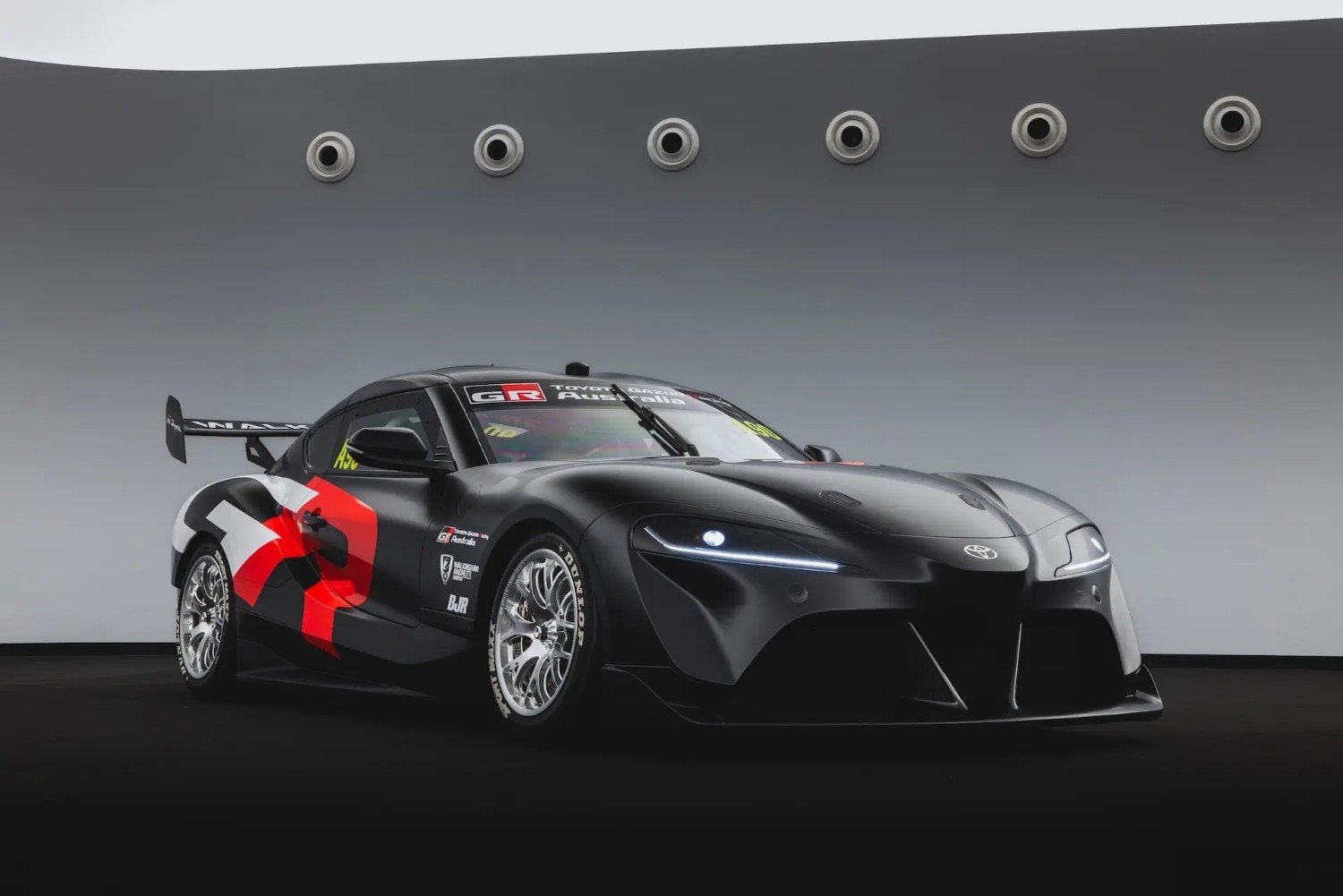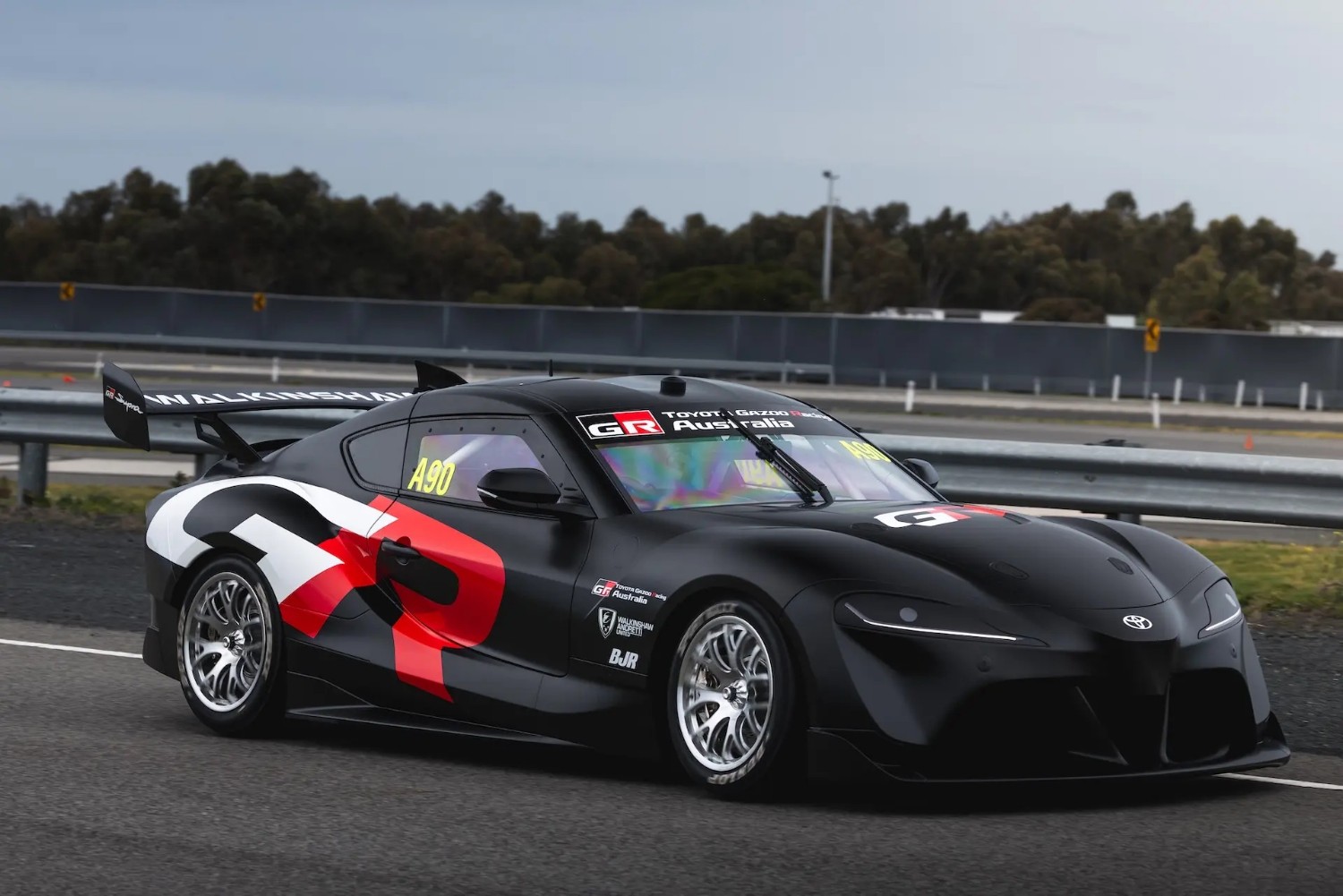Roaring Revival: The Unveiling of Toyota’s V8 Beast for Supercars
In the heart of Sydney’s bustling motorsport district, under the glow of floodlights at Toyota Australia’s sleek headquarters, the air hummed with anticipation. It was September 19, 2024—a date that would mark a seismic shift in the world of Australian Supercars Championship.
–by Mark Cipolloni–
Engineers in crisp white coats, executives in tailored suits, and a throng of journalists packed the auditorium, their whispers building like the rev of an engine on a cold start. Toyota, the Japanese giant that had long dominated global racing with its hybrid tech and reliable four-cylinders, was about to pull back the curtain on something audacious: a V8-powered Supra, ready to storm the ovals and road courses of Supercars in 2026.
The event kicked off with a video montage, flashing back to Toyota’s storied history in motorsport. From the rally-dominating Celica to the endurance-racing GR Supra in IMSA, the clips built to the present—clips of the current Gen3 Supercars era, where Ford’s Mustang and GM’s Camaro ruled with thunderous V8s. But Toyota had been absent from the top tier of Aussie tin-top racing, content with support categories. No more. “Today,” boomed the voiceover, “we unleash the beast within.”

Enter Walkinshaw Andretti United (WAU), Toyota’s chosen partner and the team tasked with bringing this vision to life. CEO Ryan Walkinshaw stepped onto the stage, his grin as wide as a Mount Panorama straight.
“Supercars is the heartbeat of Australian motorsport,” he declared, “and Toyota’s joining the party with a Supra that’s not just fast—it’s ferocious.” The lights dimmed, and a massive screen lit up with renders of the car: the iconic Supra silhouette, but bulked up for battle.
Aggressive aero kits hugged the body—splitters, diffusers, and a snarling front fascia inspired by the GR Supra GT4 racer. Side-exit exhausts protruded like fangs, promising a soundtrack that would rival the V8 thunder of rivals. The crowd erupted as the render rotated, revealing a livery tease in Toyota’s Gazoo Racing blue and red.
But the real star was under the hood. As confetti cannons fired, a team of technicians wheeled out a gleaming engine block on a custom stand. It was the 5.0-liter 2UR-GSE V8, a naturally aspirated powerhouse borrowed straight from Toyota’s luxury lineup—the Lexus LC 500, RC F, and GS F.
This wasn’t some detuned mill; it was a 472-horsepower monster, capable of revving to 7,300 rpm and delivering torque that could pin you to the seat like a launch control g-force. In Supercars spec, it would be tweaked for parity—expected to hit around 650 hp with the series’ mandatory restrictors and E85 fuel blend—but the raw DNA was unmistakable.
“This V8 is a symphony of engineering,” explained chief engineer Hiroshi Tanaka, who flew in from Toyota’s Higashi-Fuji technical center. “It’s the same heart that powers Lexus flagships, but tuned for the brutal demands of Supercars. Lightweight alloys, advanced valvetrain, and that signature high-rev wail—it’s going to shake the foundations of Bathurst.”
The unveiling tied back to a deeper strategy. Supercars’ Gen3 regulations, introduced in 2023, leveled the playing field with a common control arms and spec parts, making it easier for manufacturers like Toyota to enter without massive R&D costs. Toyota had been testing the waters with its four-cylinder GR86 in the Super2 support series, but the V8 Supra signaled full commitment.
“We’ve learned from our global programs,” Tanaka added. “The Supra’s platform is proven in GT racing, and this V8 bridges our luxury road cars with the raw aggression of Supercars.” Early simulations projected the car could lap circuits like Sydney Motorsport Park a full second quicker than the current GR Supra, thanks to the V8’s broader powerband and the aero tweaks visible in the clay model on display—a physical mockup that drew gasps for its menacing stance.
As the crowd buzzed, drivers from WAU’s lineup—veterans like Chaz Mostert and rising star Zane Goddard—took the stage for a Q&A. Mostert, fresh off a podium at the Sandown 500, couldn’t hide his excitement. “I’ve driven V8s my whole career, but a Supra with this engine? It’s like strapping a rocket to a legend. We’re aiming for the Bathurst 1000 win in our first year.”
Goddard, the young gun, echoed the sentiment: “The side exhausts alone will make it sound like a muscle car from hell. Can’t wait to unleash it.”
The announcement wasn’t without its ripples. Rival teams from Ford and GM exchanged knowing glances in the audience—Toyota’s entry would inject fresh competition and sponsorship dollars into the series, potentially drawing more international eyes.
Social media lit up instantly; renders shared by insiders like AR12Gaming went viral, racking up thousands of likes with captions hailing the “V8 Supra” as the savior of straight-line speed. One post quipped, “Finally, a Toyota that roars louder than it hybrid-whispers!”
By night’s end, as the V8 engine was fired up for a deafening demo—its bellow echoing through the halls—the message was clear: Toyota wasn’t just entering Supercars; it was redefining it.
The 2026 season loomed large, with the Supra set to debut at the Bathurst 12 Hour in February as a teaser before the full Supercars assault. For fans, it was a promise of new rivalries, epic battles, and that unmistakable V8 rumble tearing down Conrod Straight. In a championship built on legends, Toyota’s V8 Supra was poised to write the next chapter—one rev at a time.
